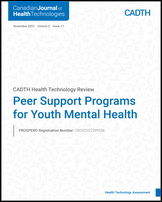|
Population
| Youth (aged between 12 and 25 years) with mental health concerns (including but not limited to depression, anxiety, suicidality, eating disorders, posttraumatic stress disorder) either self-identified or formally diagnosed. Subgroups of interest: age PROGRESS-Plus factors, 23,33 including but not limited to place of residence; race, ethnicity, culture, or language; gender or sex; and socioeconomic status mental health condition (e.g., depression, eating disorders) type of peer support (e.g., 1:1 vs. group, in person vs. virtual).
|
Age < 12 years or > 25 years. Substance use disorders or addictions as the primary concern and reason for delivering or accessing peer support. Neurodevelopmental disorders such as attention-deficit/hyperactivity disorder, autism, and learning disabilities as the primary concern and reason for delivering and accessing peer support.
|
|
Intervention(s)
| Formal peer support programsa |
Peer support programs that do not fulfill the definition (e.g., do not include formal training, shared lived experience). Support in the form of peer communication, peer-to-peer support (mutual support), or support helplines.
|
|
Comparator(s)
| Interventions without formal peer support (e.g., informal or unstructured peer support interventions, support helplines, self-help group); no intervention (including waitlist); no comparator | Not applicable |
|
Outcomes
|
Question 1
Any outcomes in the following domains, irrespective of the follow-up duration and outcome ascertainment method: personal recovery (e.g., self-efficacy, reduced stigma, HRQoL, coping strategies, client goal achievement, empowerment) clinical outcomes (e.g., recovery rates, burden of symptoms) health care resource utilization (e.g., hospitalizations, ED visits, need for other interventions) social outcomes (e.g., employment, education, stable housing, social support, social isolation).
Question 2
Any outcomes in the following domains, irrespective of the follow-up duration and ascertainment method: treatment-emergent adverse events (e.g., worsening of symptoms), over-dependence, withdrawal or discontinuation from the program, adherence, other harms (e.g., stigmatization, increased shame).b
| Not applicable |
|
Study designs
| Randomized and non-randomized study designs, including:randomized controlled trials non-randomized controlled clinical trials cohort studies (controlled or uncontrolled) case-control studies before-and-after studies (controlled or uncontrolled) interrupted time series studies (controlled or uncontrolled)
|
Cross-sectional studies Case reports Case series Qualitative studies and qualitative evidence from mixed-methods studies Evidence syntheses Protocols and trial registers Editorials, letters, and commentaries Studies of any design published as conference abstracts, presentations, thesis documents, or preprints
|
|
Time frame
| 2006 to presentc | Before 2006 |
